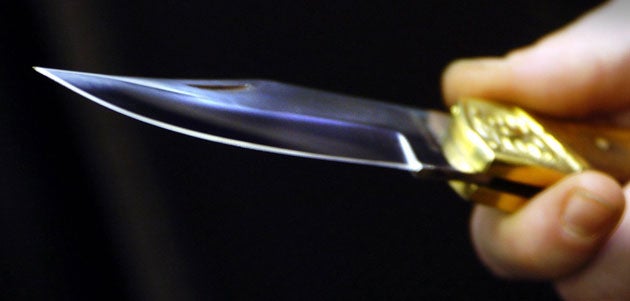Knife crime: the breakthrough
88,000 people stopped and searched in London in past year; More than 10,000 arrests at a rate of one every 51 minutes; 5,400 knives seized, 30 per cent fall in serious stabbing injuries

The Metropolitan Police's campaign to tackle knife crime among youths delivered signs of success yesterday as the force announced that stabbings, murders and other knife-related crime have fallen in the year since Operation Blunt 2 begun.
The figures show that, since the operation started in May 2008, the number of youths suffering serious stabbing injuries in London has fallen by 30 per cent, from 221 to 155, while overall knife crime, which includes any offence where a blade has been used, has fallen by 11.5 per cent – from 13,874 incidents to 12,279. Youth victims of violence have also fallen by 9.8 per cent. And, while knife-related youth murders stood at 14 this time last year, eight people under the age of 19 have been killed with a knife so far this year.
Operation Blunt 2 begun last year after the number of young people being murdered in the capital increased, with the favoured weapon being a knife. The operation widened the already operational Blunt and involved the use of random stop and search tactics and knife arches at Tube and train stations.
In the 12 months, police have stopped and searched 287,898 people in the capital, leading to 10,266 arrests – one every 51 minutes. A total of 5,480 knives were seized and 90 per cent of those caught in possession of a knife are being charged. But knives are now only found in 1 per cent of cases as opposed to 3 per cent last year. Officers accept this could be because their tactics have forced people to stop carrying knives, or because carriers are simply becoming better at avoiding detection.
The figures were released by Scotland Yard yesterday alongside a selection of the weapons that have been recovered. They included a knife disguised as a cigarette lighter, a 28cm machete and a hatchet.
Acting Deputy Commissioner Tim Godwin said that the use of stop and search tactics in non-terrorism operations had increased by 40 per cent and admitted that it can be contentious. "If you are being stopped 10 times or five times you are going to get fed up," he said.
"Every now and again the community will challenge us and that is where we have to be able to argue the reasons for doing it and generally we get support. We have maintained community support in a very sensitive area. It is not about harassing young people. It is about making a hostile environment for people carrying knives and getting weapons off the street.
"The trend in violence is downward, the trend in homicide is downward. Generally the trend is downward, but there is a lot more to do. There is still too much violence, still far too many kids carrying weapons, still far too many kids getting involved in what they would call a gang. This is not job done, it's job ongoing and we've got to maintain our focus."
Commander Mark Simmons, who leads Blunt 2, also revealed that the focus of the operation has allowed police to build intelligence on knife crime in a way that has not been done before. He said that the force has established that the busiest period of time for youth crime involving knives, such as robbery or assault, is not, as it is often believed, late at night, but in the three hours following the end of the school day.
He added: "We have got much sharper in the last year in terms of monitoring intelligence. For example, if a fight happens in a school playground, we can now work out which estate violence is likely to flare on that night and send officers there."
But, while it appears as though the operation is working, some experts have suggested that the figures were decreasing anyway, and it is too early to tell whether the latest falls are as a result of the police efforts. And they point out that, while police statistics show that knife crime is falling, not every stabbing is reported.
Roger Grimshaw, of the Centre for Crime and Justice Studies, said: "I have seen figures from the Metropolitan Police, showing that knife-related crime has, overall, been falling in London year on year since 2004. So this year on year decrease is not unexpected and may have happened with or without Blunt 2. I think it is too early to say whether the operation has been a success."
Camila Batmanghelidjh, founder of the youth charity Kids Company, added: "I am not saying these figures are not to be believed, but I would not consider them an absolute presentation of the whole picture. I know from working at street level that a vast number of stabbings never get reported to the police. The real figures rest in hospital accident and emergency figures.
"But, considering the intensity of stop and search and random knife arches, it shows that if you put the work in you can bring your figures down. I do think that stop and search and knife arches do make young people think twice about carrying a knife. If the police consider it progress then that is good enough for me. Any progress is good."
Bookmark popover
Removed from bookmarks